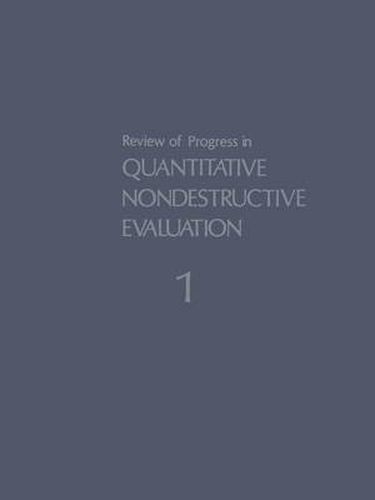Readings Newsletter
Become a Readings Member to make your shopping experience even easier.
Sign in or sign up for free!
You’re not far away from qualifying for FREE standard shipping within Australia
You’ve qualified for FREE standard shipping within Australia
The cart is loading…






This title is printed to order. This book may have been self-published. If so, we cannot guarantee the quality of the content. In the main most books will have gone through the editing process however some may not. We therefore suggest that you be aware of this before ordering this book. If in doubt check either the author or publisher’s details as we are unable to accept any returns unless they are faulty. Please contact us if you have any questions.
Perhaps the largest symposium held annually in the area of quantitative nondestructive evaluation is the one which resulted in this book. The 1981 Review of Progress in Quantitative Nondestructive Evaluation (NDE) was held August 2-7 at the University of Colorado in Boulder. While the review was sponsored by the Materials Laboratory of the Air Force Wright Aeronautical Laboratories and the Defense Advanced Research Projects Agency as part of their sponsored research conducted through the Ames Laboratory of the U.S. Department of Energy, nearly 300 attendees, representing other government agencies and the industrial and university communities as well, participated in the technical presentations, poster sessions and discussions. The program emphasized various areas of interest in quantitative NDE, including topics related to the development of quantitative ultrasonic and eddy current techniques, other emerging techniques, considerations of im provements needed in the probability of flaw detection, and engineering applications which follow from technology transfer of research results. An example of this transfer is the utilization of the Born inversion algorithm for flaw sizing. The keynote address, NDE–A Key to Enhanced Producti vity, was deli vered by Dr. Norman Tallan, Chief Scientist at the Air Force Materials Laboratory. Dr. Tallan’s presentation concerned the importance and potential pay-off of moving the NDE inspection procedure forward to provide in-process inspection and control for manufacturing. This step requires the utilization of concepts and research pursued in quantitative NDE activities and the initiation of other key steps.
$9.00 standard shipping within Australia
FREE standard shipping within Australia for orders over $100.00
Express & International shipping calculated at checkout
This title is printed to order. This book may have been self-published. If so, we cannot guarantee the quality of the content. In the main most books will have gone through the editing process however some may not. We therefore suggest that you be aware of this before ordering this book. If in doubt check either the author or publisher’s details as we are unable to accept any returns unless they are faulty. Please contact us if you have any questions.
Perhaps the largest symposium held annually in the area of quantitative nondestructive evaluation is the one which resulted in this book. The 1981 Review of Progress in Quantitative Nondestructive Evaluation (NDE) was held August 2-7 at the University of Colorado in Boulder. While the review was sponsored by the Materials Laboratory of the Air Force Wright Aeronautical Laboratories and the Defense Advanced Research Projects Agency as part of their sponsored research conducted through the Ames Laboratory of the U.S. Department of Energy, nearly 300 attendees, representing other government agencies and the industrial and university communities as well, participated in the technical presentations, poster sessions and discussions. The program emphasized various areas of interest in quantitative NDE, including topics related to the development of quantitative ultrasonic and eddy current techniques, other emerging techniques, considerations of im provements needed in the probability of flaw detection, and engineering applications which follow from technology transfer of research results. An example of this transfer is the utilization of the Born inversion algorithm for flaw sizing. The keynote address, NDE–A Key to Enhanced Producti vity, was deli vered by Dr. Norman Tallan, Chief Scientist at the Air Force Materials Laboratory. Dr. Tallan’s presentation concerned the importance and potential pay-off of moving the NDE inspection procedure forward to provide in-process inspection and control for manufacturing. This step requires the utilization of concepts and research pursued in quantitative NDE activities and the initiation of other key steps.